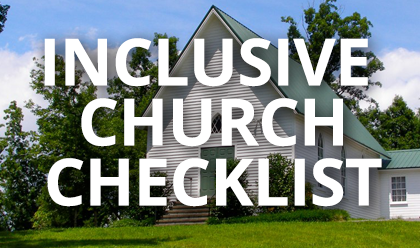Is your church welcoming of transgender people? And if it is, does anyone know?
Lots of churches declare their “open and affirming” status on their websites. Or they will put a rainbow flag on their church sign or website homepage. But those symbols often don’t tell the whole story. Many churches that have done a lot of work on gay and lesbian issues haven’t bothered to study anything about transgender people. They have outdated language on their websites or don’t mention transgender issues at all.
Some folks will ask “Why do we need to mention it at all? Why can’t we just say we welcome all people?”
Because most churches don’t. Because I’ve sat through too many services where my life and identity is either ignored or talked about badly.
If your website says nothing about transgender people I will automatically assume that you are not welcoming of transgender people.
If you are a church leader or part of a church you absolutely must understand how crucial this is if you are actually going to be welcoming to transgender people. My default stance is to assume that your church will not be welcoming because most of them are not. If your church is, you need to be upfront and clear about it.
But don’t lie. If your church needs to do work on transgender issues, you need to do that work on your own without having a transgender person be your guinea pig. Please, don’t overstate your welcome if you’re not ready to actually be welcoming.
Here are specific things I look for on a church website to see if it’s a place that I would be willing to visit:
Do you mention transgender people anywhere on your site? And if so, are you using language that is currently considered appropriate? I can’t tell you how many church websites are using “transgendered” somewhere on their sites. (Here’s an article about why that’s not the word to use.)
Do you make it a point to mention that you have gender neutral or single stall bathrooms?
Does your statement of inclusion specifically mention both gender identity and gender expression?
How do you refer to God on your website? Do you use only male pronouns? Or only binary pronouns?
Do you have lots of gender specific ministries and groups? If so do you make clear that transgender people are welcome in those groups? Do you have groups for transgender or non-binary identified people? (And really, do you need gendered groups to begin with?)
Do you mention that you welcome families with gender diverse children?
Do you mention that people can dress however they are comfortable?
Tweet it: If your church is welcoming of #transgender people, how will people know?
Along with your website, your church should actually be prepared to welcome transgender people.
Do some work with your greeters to help them understand how hurtful gendered greetings might be (even if someone doesn’t “look like” they are transgender or don’t identify with the gender they are presenting as being called by the wrong pronoun or by a gendered address can be really hurtful).
Help your folks understand that policing bathrooms is not okay. They might think they are directing someone to the “right” restroom but they are actually being hurtful. Let people use the bathroom that they want to use and let them use it in peace.
Provide an opportunity for people to give you their pronoun, whether it’s by having space for that on church name tags or as part of the greeting time.
Help people understand that it’s not okay to stare. You wouldn’t think you would have to mention this, but you do.
Help people to understand that it is not, under any circumstances, okay to out someone. Even if you think it’s “obvious” that they are transgender. Even if they have told other people. Even if it’s on their personal website/blog/facebook page/twitter account. It is not your business and not your job to out people. (I can hear your excuses now and the answer is no. Not okay.)
It is okay, without saying anything more, to correct someone who uses the wrong pronoun. Simply say, “So and so uses X pronoun.” and move on with your conversation.
These are the ones that come to mind for me. What about you?
What do you look for on church websites? What has your church done? Have you had really bad experiences at churches? Or really good ones? Tag us on social media or slide into our DMs and let us know.

Want to make sure your church is doing safety and inclusion right? We put together a 2-page checklist so you can make sure your church is LGBTQ inclusive. We know you’ve got good intentions, this is how you can make sure you’re living out those intentions.
Original photo by BurgTender

